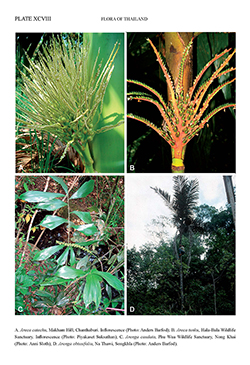e-Flora of Thailand
Volume 11 > Part 3 > Year 2013 > Page 335 > Arecaceae > Arenga
3. Arenga obtusifolia Mart.wfo-0000263720
Hist. Nat. Palm. 3: 191. 1838; Thai Forest Bull., Bot. 32: 35. 2004; Pongsatt. & Barfod, Palms 49: 5–14. 2005. Plate XCVIII: D.
Accepted Name : This is currently accepted.
Synonyms & Citations :
Description : Loosely clustered tree, to 15 m tall, pleonanthic. Stem 20–30 cm diam., internodes grey, ringed by leaf scars. Leaves 12–15 in crown, pinnate; sheath 60–100 cm long, deeply split, persietent grey, distintegrating along the margins in mesh of coarse, black fibres; petiole 30-90 cm long; rachis 4–8(–10) m long, curved distally; pinnae 100–105 on each side of rachis, 100–150 by 6–9 cm, lanceolate, evenly distributed, in one plane or slightly plumose, silvery grey below, with praemorse margins. Inflorescence 2-4, interfoliar, flowering sequence on stem acropetal; peduncle 20–75 cm long, ca 6 cm wide, upright and curved; rachis 30–75 cm long, drooping; rachillae 20–60 to 25–45 cm long, drooping. Fruit 4–6 by 3–4 cm, oblong, subtriangular in cross-section, light green when young to yellowish-green at maturity. Seed elongate, keeled, basally with white scar from the funicle.
Thailand : PENINSULAR: Ranong, Phangnga, Satun, Songkhla, Pattani.
Distribution : Peninsular Malaysia, Sumatra, Java.
Ecology : Uncommon in moist or wet forests in Peninsular Thailand, 500–800 m alt.
Vernacular : Ma phrao nu (มะพร้าวหนู)(Songkhla); phrao nu (พร้าวหนู)(Satun).
Uses: Leaf rachis for making brooms.
Conservation Status: This rare species is of considerable concern being threatened in Thailand mainly by habitat destruction.
Notes: A distinct species characterized by the clustering habit, pleonanthy with inflorescences produced in an acropetal sequence, elongate fruits and keeled seeds with a scar from the funicle.

